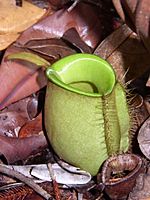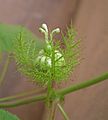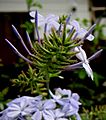Protocarnivorous plant facts for kids
A protocarnivorous plant is a special kind of plant that can catch small animals, usually insects and other tiny creatures like arthropods. They do this in ways very similar to how true carnivorous plants trap their prey. However, there's a big difference: protocarnivorous plants cannot actually get nutritients from the animals they catch. They don't have the special tools, like digestive juices, that true carnivorous plants use to "eat" their prey.
Contents
What are Protocarnivorous Plants?
Protocarnivorous plants are sometimes called "borderline" carnivorous plants. This is because they have some, but not all, of the features of a plant that truly eats insects. They are very good at trapping, but they can't break down the prey to absorb its nutrients. This means they still rely on their roots to get most of their food from the soil.
How They Trap Prey
Even though they don't digest their prey, protocarnivorous plants use clever ways to trap insects. These methods are often very similar to those used by their carnivorous cousins. Some common trapping styles include:
- Sticky traps: Some plants have sticky hairs or gooey surfaces on their leaves or stems. Insects get stuck to these surfaces, just like on flypaper. An example is Stylidium productum.
- Pitfall traps: Other plants form cup-like or pitcher-like structures that collect water. Insects fall into these "pits" and can't get out. Dipsacus fullonum uses this method with its leaves forming small pools.
- Ensnaring traps: Some plants have parts that can quickly close or entangle prey.
Why Trap if Not Eating?
You might wonder why a plant would bother trapping insects if it can't eat them. Scientists believe there are several reasons:
- Protection: Trapping insects might help protect the plant from pests that would otherwise eat its leaves or flowers.
- Nutrient help: Sometimes, other organisms, like bacteria or fungi, break down the trapped insects. The plant might then absorb some of these nutrients from the soil around its roots.
- Indirect feeding: In some cases, another animal might eat the trapped insects, and then the plant absorbs nutrients from that animal's waste. For example, the assassin bug Pameridea roridulae lives on Roridula gorgonias and eats the insects the plant traps. The plant then gets nutrients from the bug's droppings.
Images for kids
-
Mucilage-tipped bracts and immature flower of Passiflora foetida, a protocarnivorous plant.
-
Darlingtonia californica does not make its own digestive enzymes.
-
The water reservoir of Dipsacus fullonum, which acts as a pitfall trap.
See also
 In Spanish: Planta protocarnívora para niños
In Spanish: Planta protocarnívora para niños









